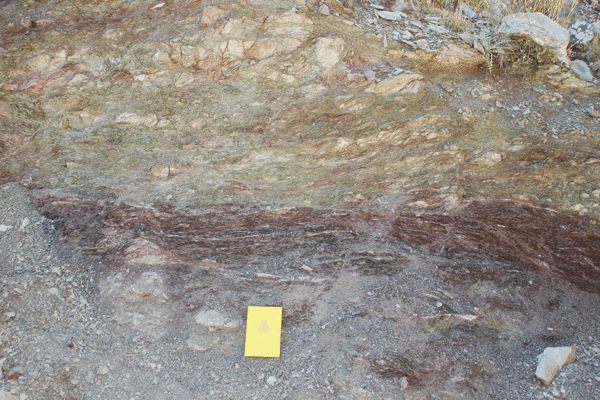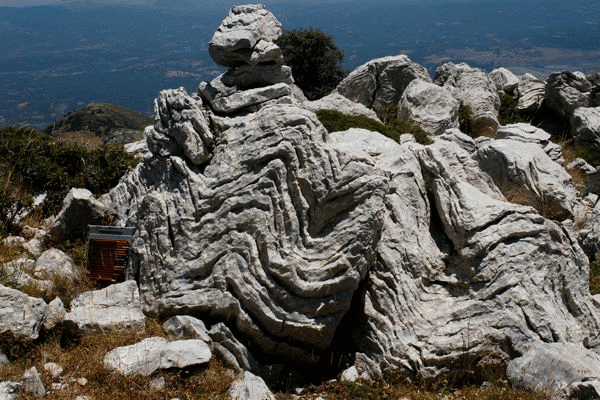VI. STRATIGRAPHY WITHIN THE SANCTUARY OF MT. LYKAION
VI-A. Previous Work
The geology of the subregion within which the Sanctuary of Zeus resides was originally mapped (1:50,000 scale) by Lalechos (1973) and Papadopoulos (1997). The full aerial dimensions of their mapping (~2,000 km2) far exceeded those of the Mt. Lykaion Sanctuary area proper (~1. 5 km2), and the aerial extent of my own mapping to date (~25 km2), which reaches out beyond the sanctuary in order to gain broader perspective. Lalechos (1973) and Papadopoulos (1997) described the nature of the lithologies and fossil assemblages within each of four Pindos Group formations they recognized: Chert Series Jurassic to Lower Cretaceous), First Flysch (Upper Cretaceous), Limestones (Upper Cretaceous), and Flysch Transition Beds (Paleocene to Eocene) (see descriptions, Appendix B).
With only modest adjustments in the names and subdivision, I basically adopted the map units established by Lalechos (1973) and Papadopoulos (1997) (Figure 10). From oldest to youngest the units are as follows: Chert Series Beds, First Flysch Beds, Thin Platy Limestone Beds, Thick White Limestone Beds, and Flysch Transition Beds. It proved useful from a mapping and structural geologic standpoint to split the Limestones formation (Lalechos, 1973; Papadopoulos, 1994; see Appendix B) into two members: a lower member, which I refer to as “Thin Platy Limestone Beds,” and an upper member, which I call “Thick White Limestone Beds” (see Figure 10). Descriptions that follow emphasize the outcrop-scale properties.
Figure 10. Stratigraphic column for study area.

Stratigraphic column showing formations of the Pindos Group exposed in the Sanctuary of Zeus study area. These units were defined during the course of this study, modified very slightly from the work of Lalechos (1973) and Papadopoulos (1997). “Limestones” of Lalechos (1973) and Papadopoulos (1997) are subdivided here into a lower unit (“Thin Platy Limestone Beds”), and an upper member (“Thick White Limestone Beds”). The contact between these two members is transitional over a thickness of ~20 m, where typical Thin Platy Limestone Beds alternate with typical Thick White Limestone Beds. Furthermore, “First Flysch” of Lalechos (1973) and Papadopoulos (1997) is referred to here as “First Flysch Beds,” and subdivided into a lower member (“Lower Brown Sandstone”), an upper member (“Upper Brown Sandstone”), and a middle member (“Red Mudstone”) in between.
VI-B. Chert Series Beds
The Chert Series Beds comprises a formation that ranges up to 100 m in thickness (see Figures 8), which is also the thickness reported by Lalechos (1973) and Papadopoulos (1997) (see Appendix B). The thin-bedded radiolarian cherts, and interbedded limestones and sandstones that make up this formation tend to be very poorly exposed. This formation is a slope former, which reflects the vulnerability of its sheared and broken character to weathering and erosion. Yet certain outstanding road-cut exposures reveal diagnostic characteristics.
One of the most distinctive expressions of the Chert Series Beds is the presence of red-purple, thin-bedded ribbon cherts (Figure 11A). Individual chert “ribbons” are typically 5 to 10cm thick and marked by very closely spaced (up to 6 cm) systematically oriented fractures (joints) that are omnipresent (see Figure 11A). The ribbon cherts are interbedded with reddish-brown and with light gray limestone interbeds (generally up to 1 m thick). The mudstones are commonly pervasively sheared (Figure 11B), especially where found in close proximity to major thrust faults. Limestone interbeds commonly display tight folding of a strongly overturned to recumbent nature (Figure 11C). Brown sandstones (generally up to several meters thick) are common within the Chert Series Beds as well. The Chert Series Beds accumulations are importantly composed of the tests of calcite-forming and silica-forming protozoans (foraminifera and radiolarian, respectively). Before dying and descending to become muddy ooze, these protozoans floated in pelagic-zone ocean waters far away from shore and 2 kms or more above the seafloor bottom in which they ultimately accumulated.
Figure 11. Outcrop expressions in Chert Series Beds
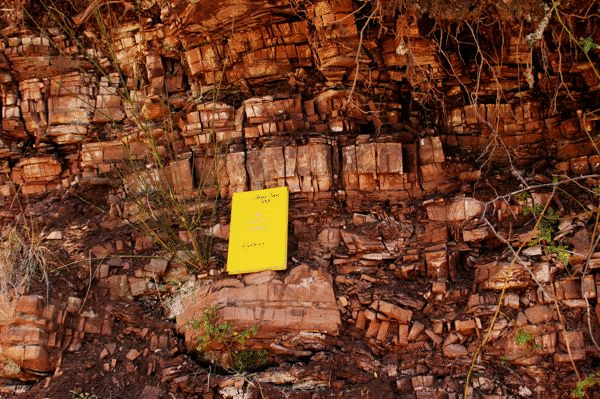
(A) Ribbon beds of radiolarian chert with layer-perpendicular closely spaced joints. Field notebook for scale.
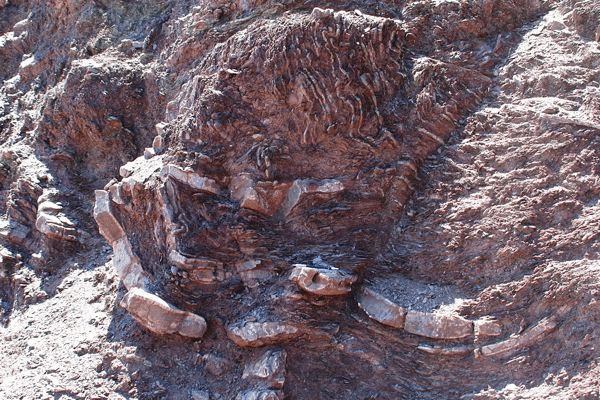
(C) Recumbent isoclinal fold in limestone layers, within radiolarian chert and mudstone sequence. Thickness of limestone layer (light gray) at base of outcrop is ~12 cm.
Lithologies within the Chert Series Beds are quite incompetent. Clearly this formation was exploited preferentially by thrust faulting and thrust shearing, offering very little resistance to compression-induced deformation, and increasing the ease with which thrust sheets were transported. The outcrop presence of Chert Series Beds is in places signaled by the presence of ‘sparkles’ on the ground, which prove to be tiny (0.5 cm X 0.5 cm and smaller) chips and flakes of siltstone, chert, and mudstone with phyllonitic surfaces produced during thrusting and shearing. The thin phyllonitic selvages are, in effect, tectonically polished bedding surfaces. From place to place there are also tectonic inclusions of spindle-shaped rock fragments (generally up to 7 cm in length), smoothed and polished through thrust shearing. The stratigraphic and structural position of Chert Series Beds has been depicted by Degnan and Roberson (1998) along sole thrusts (see Figure 9A), and this underscores the degree to which this formation was exploited geomechanically during thrusting.
The structural character of outcrops of Chert Series Beds is strongly influenced by marked contrasts in mechanical behavior. On the one hand there are the ribbon-chert layers, which in response to deformation became pervasively and systematically jointed (see Figure 11A). The joints tend to be perpendicular to bedding and spaced at intervals commonly less than bedding thickness. The result is a fracturing that, in places, resembles cleavage, and is so distinctive that the fracturing itself is a criterion for recognizing Chert Series Beds. As noted above, the brittle ribbon chert layers typically are interbedded with incompetent mudstones, and where such packages were shortened the chert layers accommodated buckling and free folding within the more ductile encompassing matrix. Some folds are upright anticlines and synclines, while others are overturned to recumbent, and in places detached through transposition in ways that outcrops reveal isolated fold hinges (see Figure 11C). Where sandstone beds crop out in the Chert Series Beds exposures, they tend to be jointed and fractured, but rarely folded. Overall the Chert Series Beds are intensely sheared, and in places have deconstructed to sticky fault gouge and quasi-foliated tectonites.
Small joint-bounded specimens of Chert Series Beds are miniature textbook displays of joint properties, including hackles, ribs, and en echelon fringe joints (Figure 12). Future work will evaluate jointing systematics within the Chert Series Beds in relation to Pindos-belt folding and thrusting.
Figure 12. Photograph of jointed specimens of bedded chert from the Chert Series Beds
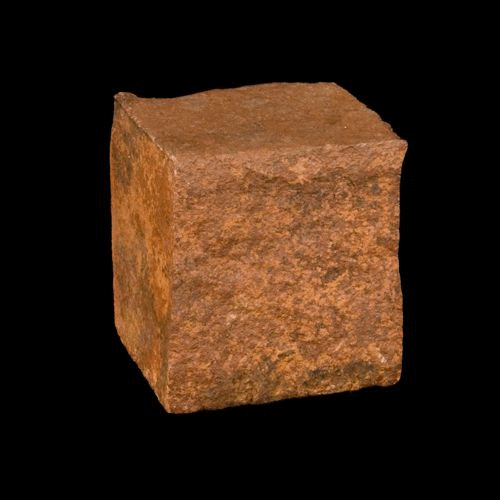
A. The upper and lower surfaces of this cube of ribbon chert correspond to bedding. The flanks of this cube are joint surfaces. Even spacing of jointing and bedding, and the orthogonal character of the joint sets resulted in ‘cubic’ weathering.
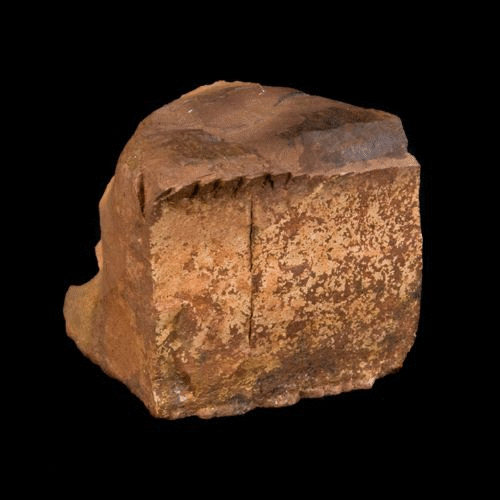
B. This wedge of chert has steep faces marked by jointing, and horizontal surfaces defined by bedding. Delicate fringes of joint surfaces are displayed by samples such as this.
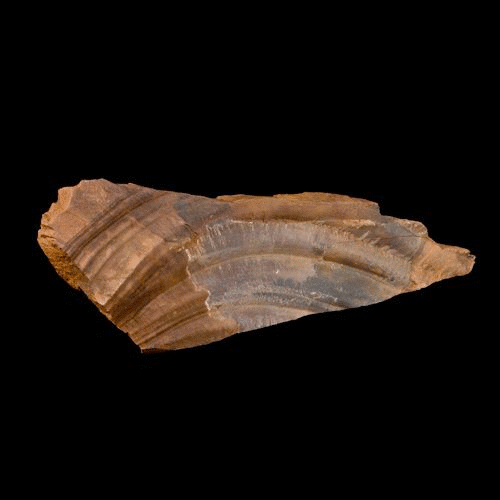
C. Part of a joint face in chert. The curved lines are traces of ribs. Tiny delicate hackles are evident in places along the ribs, and are especially pronounced where there is manganese staining.
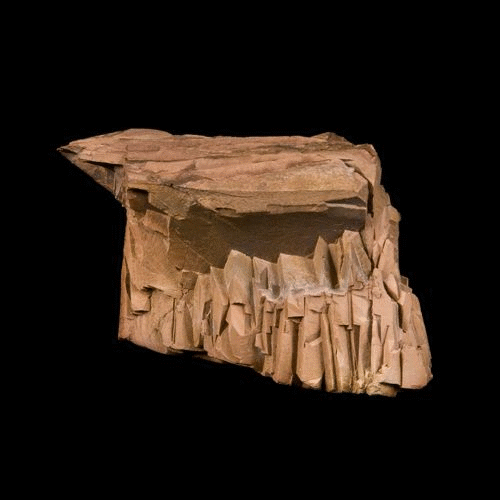
D. Very closely spaced, penetrative joining in chert, giving a sense of the very brittle nature of this rock.
VI-C. First Flysch Beds
The First Flysch Beds comprise a unit that ranges up to 155 m in thickness (see Figure 10), which is greater than the 100 m figure reported by Lalechos (1973) and Papadopoulos (1997) (see Appendix B). It is, overall, a slope-forming unit, but projecting from the moderately steep slopes there tend to be large smooth knobs and/or blocky bedrock projections (up to 10 m in topographic relief) of more resistant bedrock (Figure 13). The dominant rock type is brown sandstone, and it would be easy to assume, though falsely, that the entire formation is composed of sandstone. However, detailed geological mapping revealed an internal stratigraphy marked by upper and lower brown sandstone members ‘sandwiching’ a middle red-mudstone member. Both the upper and lower members (strictly informal designations) are composed of massive brown sandstone ranging up to 60 m and 75 m, respectively, and consisting of thick beds (up to 4 m) within a rather homogenous stratigraphic succession. The red mudstone member appear to range up to ~20 m in thickness. The red mudstone is very poorly exposed, but its presence can be inferred from reddish colluvium.
Figure 13. Sandstone outcrops of First Flysch Beds, behind spring.

Note the generally fractured character of the sandstone. First Flysch Beds rest on Chert Series Beds, which, due to shearing, create an impermeable ‘seal’ beneath the Chert Series Beds at this location. As a result, ground water within the First Flysch Beds seeps out along the spring which is evident in the foreground.
The massiveness of the brown sandstone members does not lend itself it folding. Instead, the dominant outcrop-scale structural characteristic is jointing, typically with a spacing of one or two meters. Jointing is not systematic in outcrop, neither in orientation or spacing. Instead, the jointing commonly has the appearance of irregular fracturing (Figure 14), with apparent wide-ranging orientations of the fractures and the presence of abundant curviplanar fractures.
Figure 14. Fractured sandstone of First Flysch Beds.

Outcrop expression of fracturing and jointing within sandstone of the First Flysch Beds.
Wagreich and others (1996, p. 328) emphasized that First Flysch sediments represent the first appearance of sandstones and siltstones in the deep-water Pindos basin. The shift to sandstone deposition may have occurred as a result of sea-level fall and the formation of incised valleys in the basin shelf, which became avenues for transporting the clastic material into the deeper waters (Wagreich and others, 1996).
VI-D. Thin Platy Limestone Beds
Thin Platy Limestone Beds is a formation approximately 170 m thick (see Figure 10). It is homogenous in its geological properties, consisting of even-bedded, platy limestone, with thickness of individual beds typically ranging between 20 cm and 35 cm (Figure 15A). The appearance of the thick sequence of limestone signals a shelf margin of the Pindos Basin rich in carbonate platforms. Large volumes of eroded carbonate debris would periodically be carried via submarine turbidity currents down the slope, creating limestone deposits on the basin bottom (Degnan and Robertson, 1998).
Figure 15. Photographs of outcrop character of Thin Platy Limestone Beds
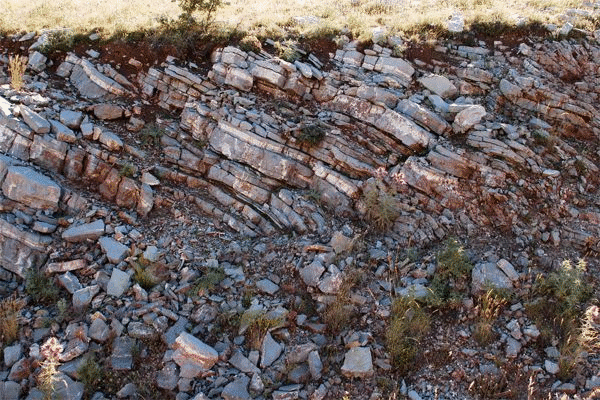
A. Typical even-bedded, thin-bedded limestone with concordant chert layers, which in this example are white. Chert layers in this outcrop are ~10 to 15 cm thick.
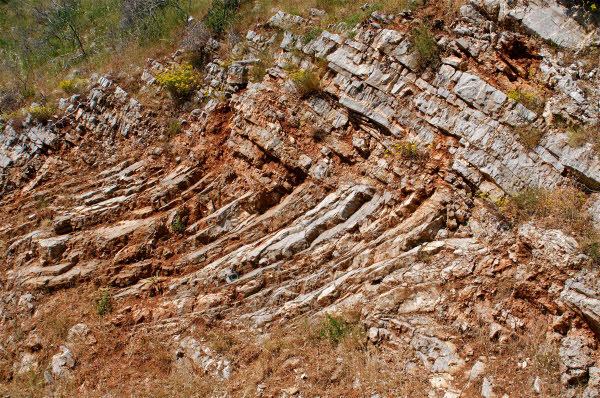
B. Here the limestone displays the typical combination of thin bedding, closely spaced fracturing, and chevron folding. Compass barely visible near center of photograph, at base of prominent white limestone bed in lower limb.
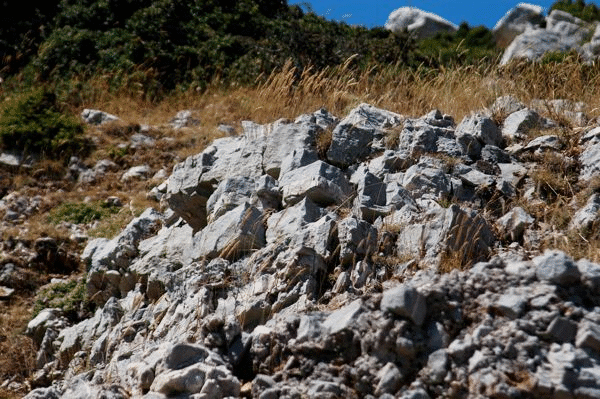
C. Because the thickness of bedding and the spacing of fractures are essentially the same, weathering and erosion of this formation creates a blocky, ‘cider-block’ appearance.
Fractures (joints) are abundant in Thin Platy Limestone Beds, in the form of planar, parallel surfaces that cut nearly perpendicular to bedding and spaced typically 20 to 40 cm apart (Figure 15B). The limestone is light to medium gray in color. This gray tone is embellished by the presence of both black and white chert nodules and layers that abundantly occur within the Thin Platy Limestone.
Displays of Thin Platy Limestone Beds in roadcuts are quite inviting, displaying ubiquitous chevron fold structures (commonly overturned) and the eye-catching combination of limestone and chert (see Figure 15B). The fold forms are ones whose geometric and structural properties are derived from the flexural-slip mechanism of folding (Ramsay, 1974). Thin mudstone and claystone layers (up to several centimeters in thickness) commonly separate the limestone beds from one another, thus revealing that the frictional resistance to slip along bedding planes may have been vanishingly small during folding. In the creases of the folds the effects of tight compression are evident, both in the local presence of tectonic stylolites and fiber veins.
Roadcut exposures of the Thin Platy Limestone Beds give the impression that this formation, dominated by competent limestone and chert, should boldly crop out in the general landscape and thus be a cliff- or bench former. Ironically, this is not generally the case. Instead, hill slopes underlain by Thin Platy Limestone Beds either are smoothly eroded (topped by soil and brushy vegetation) or covered in rubble and scree in the form of limestone blocks, about the size of cinder blocks. This characteristic weathering is attributable here to bedding thickness and fracture spacing being essentially the same within this formation. Thus from a macro view the Thin Platy Limestone Beds is a formation composed of billions of tiny polygonal blocks (Figure 15C), which work themselves loose by the action of thermal expansion and contraction (during freezing and thawing) along with the general effects of water moving along the cracks, goats trafficking up and down the hill slopes, and gravity relentlessly tugging at the slopes
VI-E. Thick White Limestone Beds
The Thick White Limestone Beds comprises a formation that ranges up to ~300 m in the study area (see Figure 10). Although Lalechos (1973) and Papadopoulos (1997) reported 200 m as the maximum thickness of their Limestones unit in the sheets they mapped (see Appendix B), the total thickness of their Limestones unit as estimated here is ~520 m, which includes the sum of thicknesses of the Thin Platy Limestone Beds and the Thick White Limestone Beds.
Thick White Limestone Beds is very distinctive (Figure 16A) and, like the Thin Platy Limestone Beds, is uniform in its characteristic properties. The basic elements throughout the formation are bright white limestone beds that tend to range from 1-4 m in thickness, which is a bedding thickness distinctively greater than that of the Thin Platy Limestone Beds. The contact between Thin Platy Limestone Beds and Thick White Limestone Beds is a transitional sequence, no thicker than ~50m, consisting of an interbedding of the characteristic rock properties of each formation.
Figure 16. Photographs of outcrops of Thick White Limestone Beds
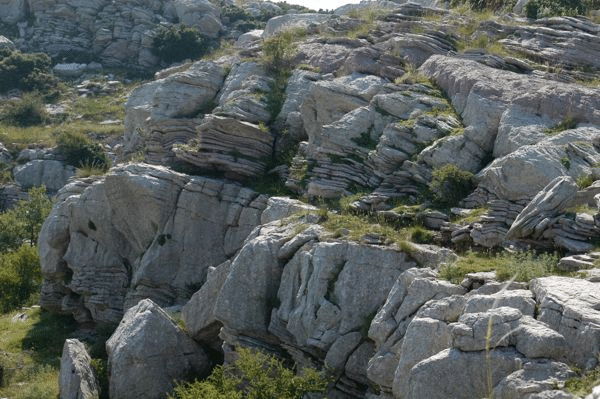
A. Good example of the bench- and cliff-forming nature of this resistant limestone formation. Lower massive layer is ~5m thick.
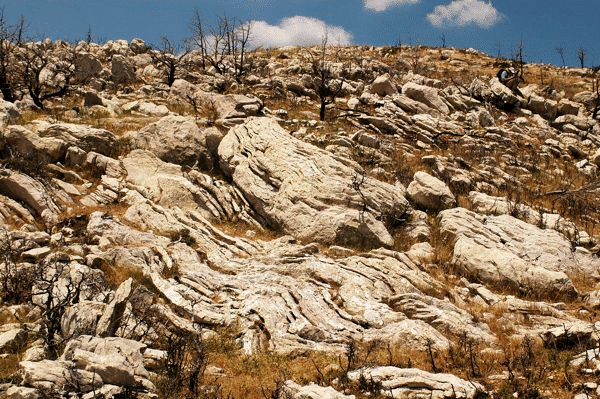
B. Bold exposures of Thick White Limestone Beds. Vegetation at this location was burned away during the fires of the summer of 2007. Note geologist (Phil Nickerson) in upper right hand corner of photograph.
The physical expression of Thick White Limestone Beds is conspicuous and easily recognized in the landscape, particularly given the bright white massive outcrops. Commonly this formation is abundantly covered with tough shrubs, bushes, and trees, in part because the ruggedness of the projecting and protruding thick white layers of sharp and resistant limestone outcrops does not lend itself to land clearing and/or terracing, nor to efficient goat grazing. The fires of 2007 locally had the effect of “clearing” some of the vegetation, creating even fuller exposures of the resistant Thick White Limestone Beds (Figure 16B). Furthermore, the Thick White Limestone Beds is ubiquitously and beautifully folded (Figure 17), commonly in the form of upright to slightly asymmetrical anticlines and synclines. Even where not folded, the bedding typically is marked by broad, gentle undulations (see Figure 16B).
Figure 17. Photographs of folding within Thick White Limestone Beds
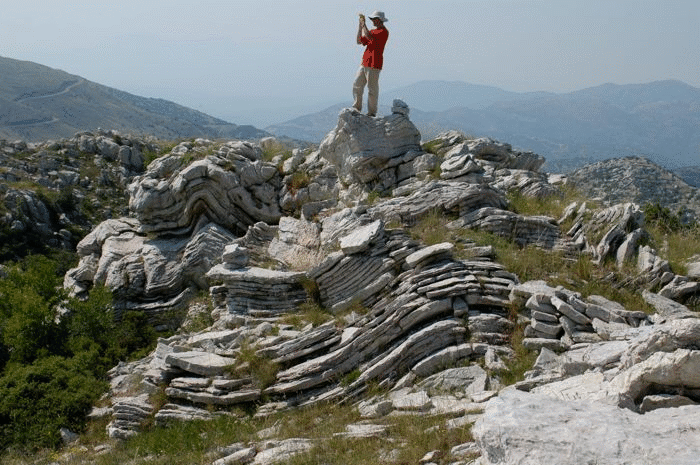
A. Upright anticlines and synclines in the lower part of the Thick White Limestone Beds. Tom Fenn’s hand-held GPS receiver is catching satellite signals. Road to Agios Elios in background. View to the southeast.
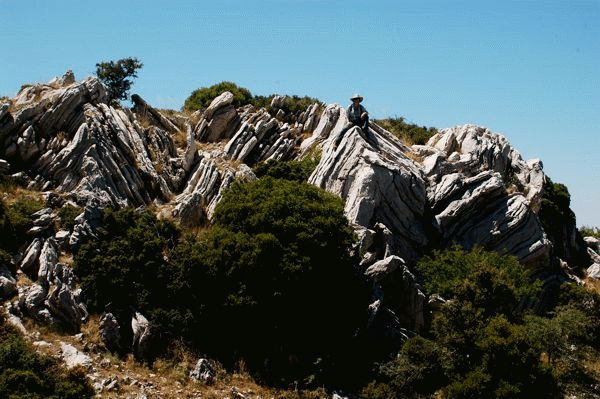
C. More upright anticlines and synclines. Randy Goosen is the geologist on the crest of one of the chevron anticlines.
One of the peculiar but diagnostic characteristics of Thick White Limestone Beds is the presence of what I refer to as “stylobedding,” which is a type of pseudobedding. An example is shown in Figure 17B, where proper bedding planes do not exist, and instead there are bedding-parallel surfaces that are quite tightly curviplanar in detail, and which have been attacked by significant differential weathering and erosion. Another really good example is pictured in Figure 18, where folded “bedding” in a large mass of limestone float is actually folded pseudobedding. Stylolites are the controlling structure, and these are concordant to bedding and reflect an origin of pressure dissolution during burial and compaction within the deep Pindos Basin. I refer to these as “bedding stylolites” as opposed to “tectonic stylolites.” Stylolitic teeth and cones are oriented perpendicular to bedding. Fresh exposures of stylolites in this formation can be seen at the Temple of Apollo at Bassai, which lies just 5 km west of Mt. Lykaion. As part of restoration engineering, modern masons are cutting and fashioning blocks of Thick White Limestone Beds there, and thus creating fresh exposures of the limestone and stylolites contained therein (Figure 19A). The original drums and blocks in the Temple of Apollo at Bassai display the stylolites in a very prominent manner, and these patterns of stylolites, in my view, add to the beauty of the architecture (Figure 19B). All of the blocks comprising the remains of built structures within the Sanctuary of Zeus (e.g., stoa, baths, seatwall, xenon, column bases, fountain house, …) are derived from the Thick White Limestone Beds formation, for its thick-bedded nature and strength made it the best suited raw material for such purposes (Figure 19C). Probably none of the other formations would have worked
Figure 18. Float block of tightly-folded stylobedding in Thick White Limestone Beds.

Example of stylobedding in a large mass of limestone float. The rock looks as if someone outlined the ‘bedding’ surfaces with a black magic marker, so prominent are the weathered and eroded stylolitic surfaces.
Figure 19. Stylolites in Thick White Limestone Beds.
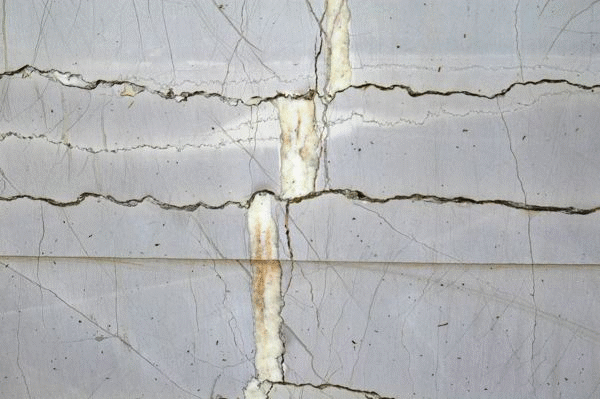
A. Fresh exposure of stylolites in a block of Thick White Limestone Beds. The locale is the Temple of Apollo at Bassai, where restoration work is taking place and new building blocks are being created. The stylolite seams are marked by characteristic teeth and cones, and are lined by insoluble residue (dark seams). The fact that stylolites develop through pressure-solution loss of material is quite apparent, for a limestone vein is cut in several places by stylolites, and dissolution along these has created the offsets of the vein.
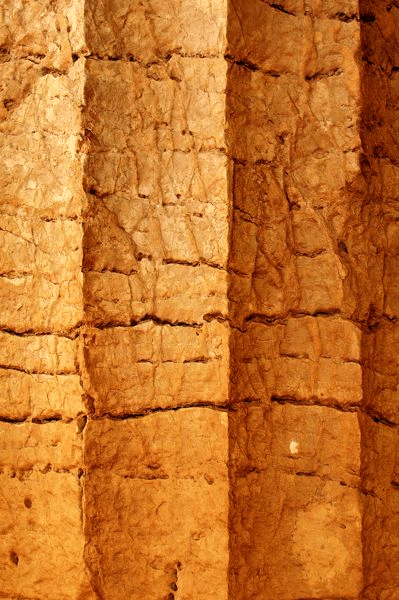
B. Ancient drums and blocks at Bassai were chiseled from Thick White Limestone Beds and display the character and penetrative nature of stylolites, the control for pseudobedding.
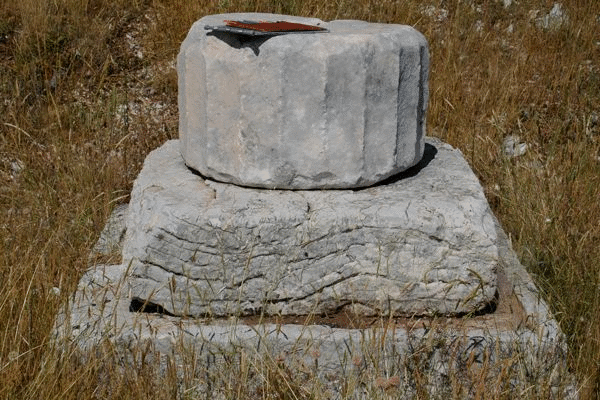
C. All of the blocks in the built structures at the Sanctuary of Zeus at Mt. Lykaion are derived from Thick White Limestone Beds. In this case we see one of the column bases just east of the temenos in the upper part of the sanctuary. In fact, Pausanias (8.38.7) referred to the columns: “Before the altar on the east stand two pillars, on which there were of old gilded eagles.”
VI-F. Flysch Transition Beds
The Flysch Transition Beds (see Figure 10) represents the youngest formation in the area, with a thickness difficult to estimate confidently (at this time) because of the abundance of internal folding. Lalechos (1973) and Papadopoulos (1997) estimate its thickness at 50 m (see Appendix B), but mapping carried out in this study suggests that it may be as thick as 100 m or more. Turbidites within the Flysch Transition Beds are the products of submarine debris flow propelled by turbidity currents, which moved silty and sandy material from the shelf margins of the Pindos basin down and onto the abyssal plain of the Pindos ocean, where – between successive debris flows - they became interbedded with limestones. The sand, silt, and mud comprising Flysch Transition Beds were derived from erosion of the uplifts created by thrust faulting and folding during closure of the Pindos basin (Degnan and Robertson, 1998).
This formation is marked by a wide variety of alternating lithologies, which markedly pronounces its bedded, stratified, layered appearance (Figure 20A). Limestone beds (typically ranging up to 50 cm in thickness) make up more than 50% of the formation. The limestones are interbedded with fissile red mudstones, jointed brown and beige sandstones, siltstones, fissile marls, and occasional chert layers. Some thin, fissile limestone beds have a glassy-sounding resonance when struck with a hammer.
Figure 20. Flysch Transition Beds.
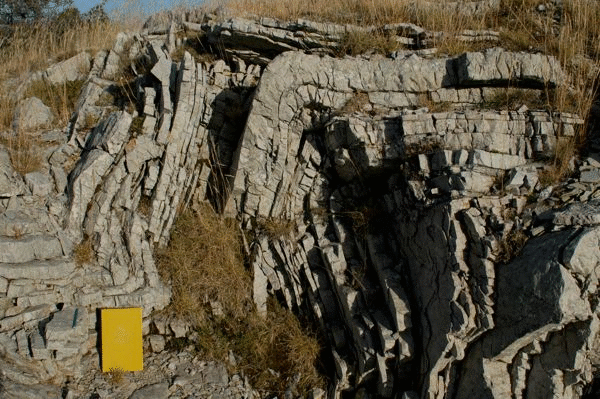
A. Outcrop of folded limestone, with fracture-like features that may well be incipient spaced cleavage. Field notebook for scale.
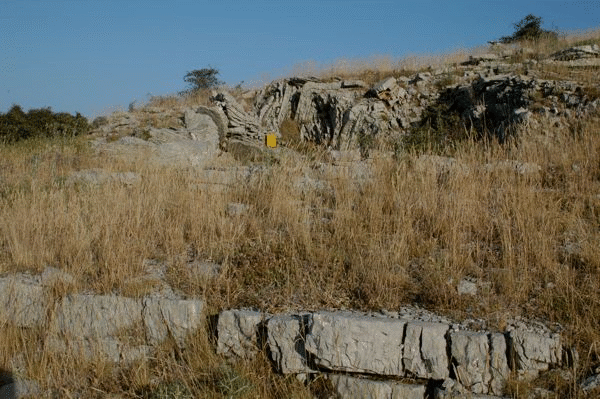
B. The fold presented above, in A, is in the background. The foreground shows flat-lying, unfolded limestone. A small detachment separates these two outcrop domains. The detachment probably is marked by shale/mudstone interbeds in the formation.
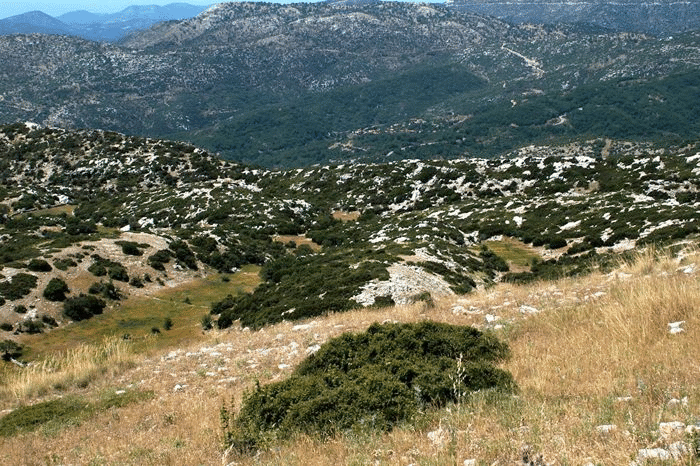
C. Example of the typical geomorphic expression of Flysch Transition Beds in the area. Weathering and erosion transforms the bedrock into distinctive corrugated linear ridges. In the background is an immense expanse of Thick White Limestone Beds.
The internal stratigraphy of the Flysch Transition Beds lends itself to pervasive internal folding, for bedding surfaces penetrate the formation and there are plentiful incompetent interbeds that undoubtedly reduced sliding friction during bedding- plane slippage when folded (see Figure 20A). Folding within this formation is most evident in the limestone beds, because these beds crop out differentially and prominently. Not uncommonly the limestone beds in a given fold are seen to have tightened downward (during folding) to the point where no more shortening by folding was possible, whereupon the beds became detached from underlying incompetent lithologies, such as shales and mudstones, which may show no evidence of folding at all at that location (Figure 20B).
The landscape expression of Flysch Transition Beds is quite distinctive in the study area, in the form of mullion-shaped hillocks that have the appearance of flat-topped, linear corrugations, several hundreds of meters in length, 25 to 40 m or so in topographic relief. Narrow drainages straddle them on either side (Figure 20C). The upper surfaces of these corrugated ridges tend to have a flat, faceted appearance.
